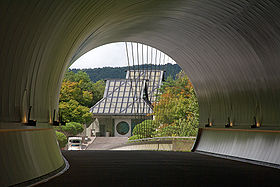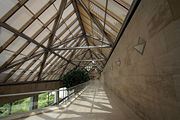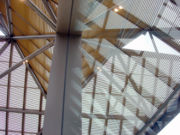
Miho Museum
Encyclopedia

Kyoto
is a city in the central part of the island of Honshū, Japan. It has a population close to 1.5 million. Formerly the imperial capital of Japan, it is now the capital of Kyoto Prefecture, as well as a major part of the Osaka-Kobe-Kyoto metropolitan area.-History:...
, Japan
Japan
Japan is an island nation in East Asia. Located in the Pacific Ocean, it lies to the east of the Sea of Japan, China, North Korea, South Korea and Russia, stretching from the Sea of Okhotsk in the north to the East China Sea and Taiwan in the south...
, near the town of Shigaraki
Shigaraki, Shiga
was a town located in Kōka District, Shiga, Japan.On October 1, 2004 Shigaraki was merged with the towns of Kōka, Kōnan, Minakuchi and Tsuchiyama, all from Kōka District, to form the new city of Kōka....
, in Shiga Prefecture
Shiga Prefecture
is a prefecture of Japan, which forms part of the Kansai region on Honshu Island. The capital is the city of Ōtsu.- History :Shiga was known as Ōmi Province or Gōshū before the prefectural system was established...
. The museum was the dream of Mihoko Koyama (after whom it is named), the heiress to the Toyobo
Toyobo
is one of Japan's top makers of fibers and textiles, including synthetic fibers and natural fibers, such as cotton and wool. The company's textiles are designed for clothing, home furnishings, and for industrial uses. Its textiles include spandex yarn for apparel, polyurethane fiber for pantyhose,...
textile business, and one of the wealthiest women in Japan. In 1970 Koyama founded the Shinji Shumeikai
Shinji Shumeikai
is a Japanese shinshūkyō, or new religious movement. As of 1998, the organization had more than 300,000 adherents.- Beliefs :...
spiritual movement which is now said to have some 300,000 members worldwide. Furthermore, in the 1990s Koyama commissioned the museum to be built close to the Shumei temple in the Shiga mountains.
Collection
The Miho Museum houses Mihoko Koyama's private collection of Asian and Western antiques, as well as other pieces with an estimated value of between US$300 million to US$1 billion, bought on the world market by the Shumei organisation in the years before the museum was opened in 1997. There are over two thousand pieces in total, of which approximately 250 are displayed at any one time.Architecture


I. M. Pei
Ieoh Ming Pei , commonly known as I. M. Pei, is a Chinese American architect, often called a master of modern architecture. Born in Canton, China and raised in Hong Kong and Shanghai, Pei drew inspiration at an early age from the gardens at Suzhou...
had earlier designed the bell tower at Misono, the international headquarters and spiritual center of the Shumei organization. Mihoko Koyama and her daughter, Hiroko Koyama, again commissioned Pei to design the Miho Museum. The bell tower can be seen from the windows of the museum.
I. M. Pei's design, which he came to call Shangri-La
Shangri-La
Shangri-La is a fictional place described in the 1933 novel Lost Horizon by British author James Hilton. Hilton describes Shangri-La as a mystical, harmonious valley, gently guided from a lamasery, enclosed in the western end of the Kunlun Mountains...
, is executed in a hilly and forested landscape. Approximately three-quarters of the 17,400 square meter building is situated underground, carved out of a rocky mountaintop. The roof is a large glass and steel construction, while the exterior and interior walls and floor are made of a warm beige-colored limestone
Limestone
Limestone is a sedimentary rock composed largely of the minerals calcite and aragonite, which are different crystal forms of calcium carbonate . Many limestones are composed from skeletal fragments of marine organisms such as coral or foraminifera....
from France
France
The French Republic , The French Republic , The French Republic , (commonly known as France , is a unitary semi-presidential republic in Western Europe with several overseas territories and islands located on other continents and in the Indian, Pacific, and Atlantic oceans. Metropolitan France...
– the same material used by Pei in the reception hall of the Louvre
Louvre
The Musée du Louvre – in English, the Louvre Museum or simply the Louvre – is one of the world's largest museums, the most visited art museum in the world and a historic monument. A central landmark of Paris, it is located on the Right Bank of the Seine in the 1st arrondissement...
.

